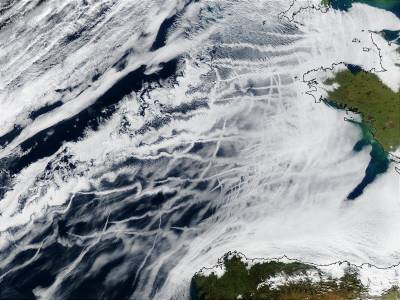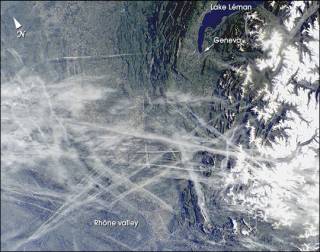|
|
 |
|
|
|
 |
| |
|
|
 |
Clouds & Particles
More |
Properties of particles
Depending on their source and evolution in the atmosphere, particles have different sizes and concentrations (physical characteristics); but there is also an important distinction between particles: their chemical composition. By the way, physical and chemical composition of a particle has a strong impact on its behaviour in the atmosphere. One reason why aerosols are of such an importance is that they are essential for the formation of clouds. |
|
|
|
|
 |
Chemical composition of aerosols
Chemical composition of particulate matter is strongly related with its source.
Major components are sea-salt, sulphate, nitrate, ammonium, organic material, crustal species, trace metals and water.
In the coarse fraction (diameter of particles > 1µm) are usually found crustal species (silicon, magnesium, calcium, aluminium...), sodium chloride (from sea-spray), primary biological elements (pollens, spores, insects debris...), coal fly ash.
The fine particles are mostly composed of secondary aerosols (produced by gas-to-particle conversion), like sulfate, nitrate, organic compounds, and of metals (like lead, iron, copper, nickel...) and elemental carbon. |
Chemical mixing
As atmosphere is continuously moving and changing, the chemical composition of a particle is likely to evolve during its atmospheric residence time of a few days. Two mixing state are distinguished: internal and external mixture. |
|
In an external mixture, particles from different sources remain separated, i.e. not attached to each others. |
 |
In an internal mixture, the various chemical components are mixed within a single particle. The more aged the air mass is, the more the degree of internal mixing will increase. |
 |
 |
|
1. TEM image of mineral dust collected from the marine troposphere. Copyright © 1999, The National Academy of Sciences
|
Cloud Condensation nuclei
One of the most important role of aerosols in the atmosphere is that they allow clouds to form : in fact, water vapour need those tiny particles to condense on. Not all the aerosol particles can serve as a nucleus for water droplet formation. Particles that have the ability to grow to become a droplet are called Cloud Condensation Nuclei (CCN). This ability depends on the particle size, chemical composition, and supersaturation (see formation processes).
The fraction of aerosol particles that are CCN is usually more important over the oceans, than in polluted environments. But as the concentration of total aerosol particles is considerably higher in polluted areas, concentrations of CCN are around 100 per cm3 in maritime air masses, while concentrations of many hundreds of CCN per cm3 are found in polluted air masses.
To act as CCN, particles must be hygroscopic enough, i.e. they must contain sufficient amount of water-soluble material. That is why their chemical composition also control the cloud droplets formation. For example, soil dust particles, when they are just emitted, can’t act as CCN, whereas sea-salt particles do (on humid days, you may find it difficult to pour salt from the shaker because water vapor has condensed on the salt crystals, sticking them together.). |
 |
 |
|
2. Ship tracks: particles emitted in the exhaust of large ships act as CCN and form the clouds that are pictured in the image. France is on the right and Spain at the bottom of image. As the ships moved about the East Atlantic, these clouds formed, leaving a visible record of where the ships had recently been. Ship tracks can last for hours, and give clues asto their age and the relative speed of the ships by their shape. The faster the ship, the narrower, longer the ship track will be. Slower ships will leave shorter and wider ship tracks. Source: NASA.
|
Aerosols effects on clouds
Thus, aerosol particles allow clouds to form. Size and number of particles must therefore change the characteristics of clouds. In fact, aerosols are essential players in the cloud system, by modifying the microphysic of clouds (number and size of droplets), the precipitation potential, and the optical properties.
One of the fundamental observations is that by increasing the number of particles in the atmosphere upon which cloud droplets can form, clouds will have more, but smaller, droplets. And number and size of droplets are important in the cloud rain production and optical properties (influence of aerosols on clouds is called "indirect effect"). |
Therefore, as anthropogenic activities are an important source of particulate matter, human do modify the number and characteristics of clouds.
Look at the photograph on the left: it shows condensation trails (also called "contrails") over the Rhône Valley in France. You can often see those artificial clouds that form in the wake of jet liners. They are made of ice crystals that form where air temperatures at altitude are lower than about -40°C. It is estimated that these “artificial clouds” cover 0.1% of the planet's surface.
|
 |
 |
 |
|
3. Source: NASA.
|
|
 |
 |
4a. You often see contrails in the sky during nice days. |
|
 |
 |
 |
4b. Authors: C. Gourbeyre, J. Gourdeau. |
|
About this page...
Author: J. Gourdeau, LAMP Clermont-Ferrand, France
Scientific reviewing: Dr Paolo Laj, LaMP, France.
Date of generation: 2003-10-15; Last published: 2004-04-21. |
|
 |
|









